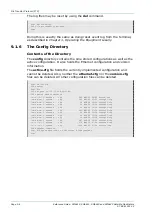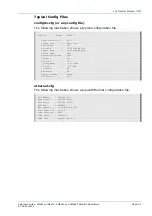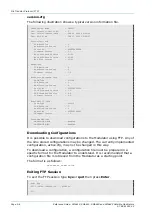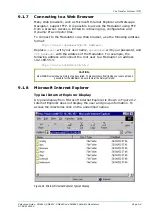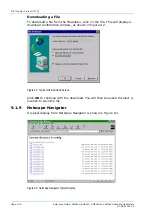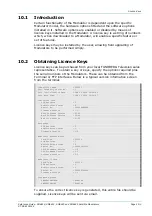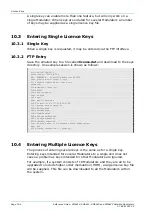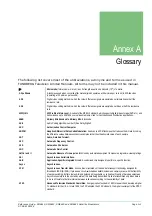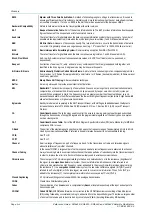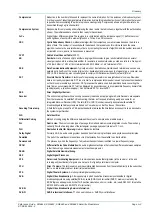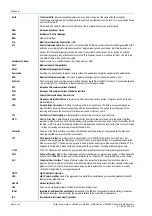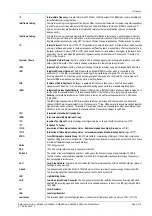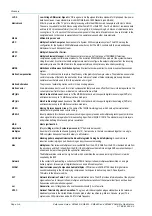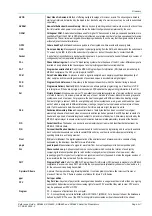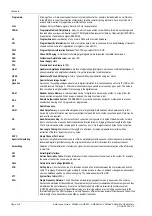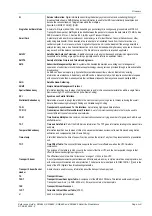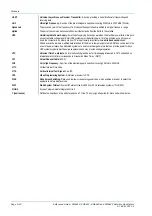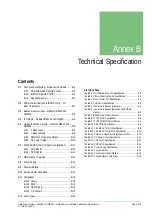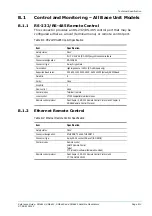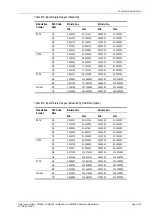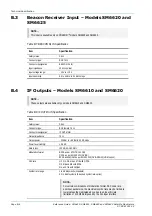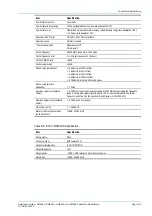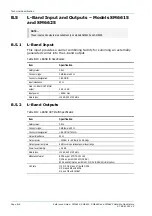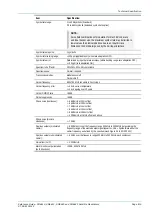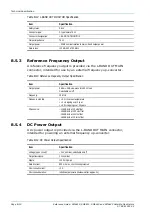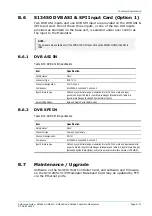
Glossary
Page A-6
Reference Guide: SM6610, SM6615, SM6620 and SM6625 Satellite Modulators
ST.RE.E10152.2
LVDS
Low Voltage Differential Signal:
LVDS is a generic multi-purpose Interface standard for high speed / low power
data transmission. It was standardised in ANSI/TIA/EIA-644-1995 Standard (aka RS-644).
Macroblock
A 16x16-pixel area of the TV picture. Most processing within the MPEG domain takes place with macro blocks.
These are converted to four 8x8 blocks using either frame DCT or field DCT. Four 8 x 8 blocks of luminance data
and two (4:2:0 chrominance format), four (4:2:2) or eight (4:4:4) corresponding 8 x 8 blocks of chrominance data
coming from a 16 x 16 section of the luminance component of the picture. Macroblock can be used to refer to the
sample data and to the coded representation of the sample values and other data elements.
Mbit/s
Million bits per second.
MCC
Multiplex Control Computer:
A component of a System 3000 compression system. The MCC sets up the
configuration for the System 3000 Multiplexers under its control. The MCC controls both the main and backup
Multiplexer for each transport stream.
MCPC
Multiple Channels Per Carrier.
MEM
Multiplex Element Manager:
A GUI based control system, part of the range of TANDBERG Television
compression system control element products. The evolution 5000 MEM holds a model of the system hardware.
Using this model, it controls the individual system elements to configure the output multiplexes from the incoming
elementary streams. The MEM monitors the equipment status and controls any redundancy switching.
MMDS
Multichannel Microwave Distribution System:
A terrestrial microwave direct-to-home broadcast transmission
system.
Motion Compensation
The use of motion vectors to improve the efficiency of the prediction of sample values. The prediction uses motion
vectors to provide offsets into the past and/or future reference frames or fields containing previously decoded
sample values that are used to form the prediction error signal.
Motion Estimation
The process of estimating motion vectors in the encoding process.
Motion Vector
A two-dimensional vector used for motion compensation that provides an offset from the co-ordinate position in the
current picture or field to the co-ordinates in a reference frame or field.
MP@ML
Main Profile at Main Level:
A subset of the MPEG-2 standard, which supports digital video storage (DVD etc.)
and transmissions up to 15 Mbit/s over various mediums.
MP@HL
Main Profile at High Level:
A subset of the MPEG-2 standard, which supports digital video storage (DVD etc.)
and transmissions up to 80 Mbit/s over various mediums.
MPEG
Moving Pictures Experts Group:
The name of the ISO/IEC working group, which sets up the international
standards for digital television source coding.
MPEG-2
Industry standard for video and audio source coding using compression and multiplexing techniques to minimise
video signal bit-rate in preparation for broadcasting. Specified in ISO/IEC 13818. The standard is split into layers
and profiles defining bit-rates and picture resolutions.
MSB
Most significant bit.
Msymbol/s
(Msym/s)
Mega
(million)
Symbols per second
(10
6
Symbols per second).
Multiplex
A number of discrete data streams (typically 8 to 12), from encoders, that are compressed together in a single
DVB compliant transport stream for delivery to a Modulator.
MUSICAM
Masking pattern adapted Universal Sub-band Integrated Coding And Multiplexing:
An audio bit-rate
reduction system relying on sub-band coding and psychoacoustic masking.
Mux
Multiplexer:
Transmission Multiplexer: receives EMMs from the ACC, ECMs from the BCC, video/audio data from
the encoders, and the SI stream from the SIC. It then multiplexes them all into a single DVB-compliant transport
stream, and delivers the signal to the uplink after modulation.
The Multiplexer also contains the cypher card, which scrambles the services according to the control words
supplied by the BCC.
Network
In the context of broadcasting: a collection of MPEG-2 transport stream multiplexes transmitted on a single
delivery system, for example, all digital channels on a specific cable system.
NICAM
Near Instantaneously Companded Audio Multiplex:
Official name is NICAM 728.
Used for digital stereo
sound broadcasting in the UK employing compression techniques to deliver very near CD quality audio.
728 refers to the bit-rate in kbit/s.
NIT
Network Information Table:
Part of the service information data. The NIT provides information about the physical
organisation of each transport stream multiplex, and the characteristics of the network itself (such as the actual
frequencies and modulation being used).
nm Nanometre:
a unit of length equal to one thousand millionth (10
-9
) of a metre.
NTSC
National Television Systems Committee:
The group, which developed analogue standards used in television
broadcast systems in the United States. Also adopted in other countries (e.g. Mexico, Canada, Japan). This
system uses 525 picture lines and a 59.97 Hz field frequency.
Содержание SM6610
Страница 10: ...Introduction Page 1 2 Reference Guide SM6610 SM6615 SM6620 and SM6625 Satellite Modulators ST RE E10152 2 BLANK...
Страница 138: ...Equipment Description Page 7 2 Reference Guide SM6610 SM6615 SM6620 and SM6625 Satellite Modulators ST RE E10152 2 BLANK...
Страница 172: ...Licence Keys Page 10 2 Reference Guide SM6610 SM6615 SM6620 and SM6625 Satellite Modulators ST RE E10152 2 BLANK...

